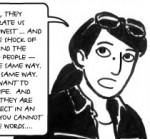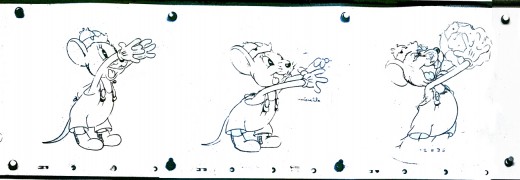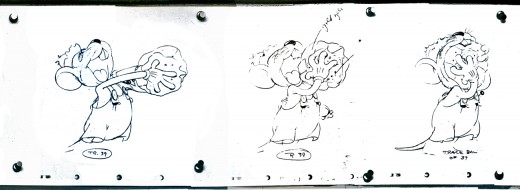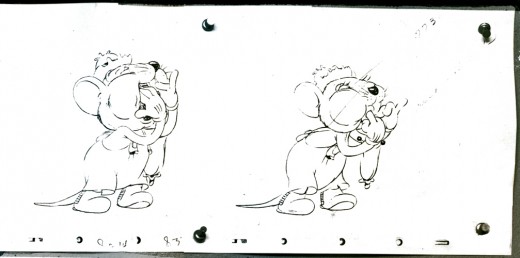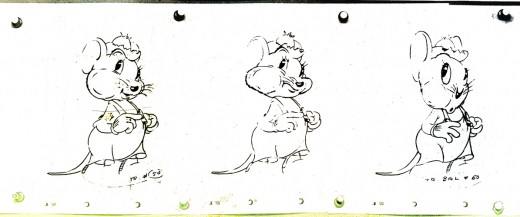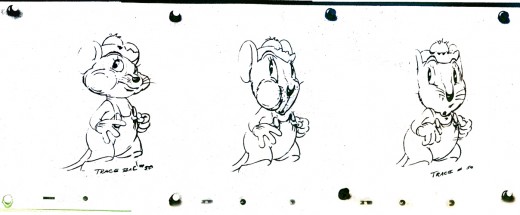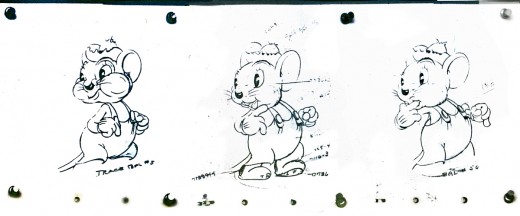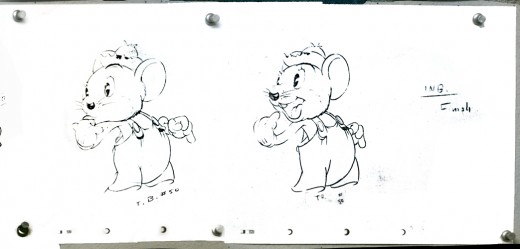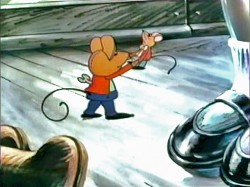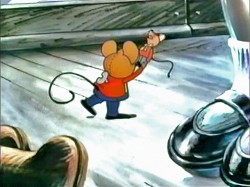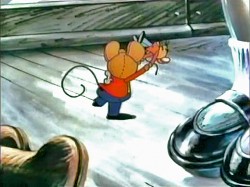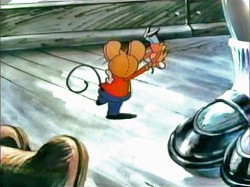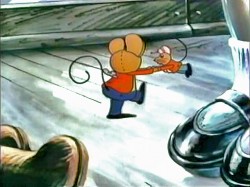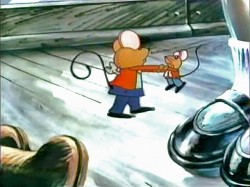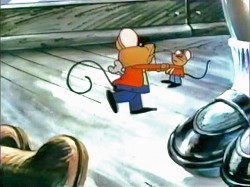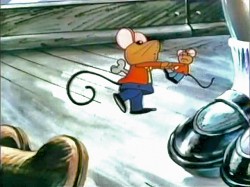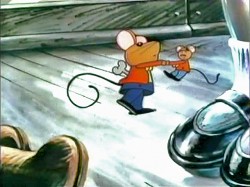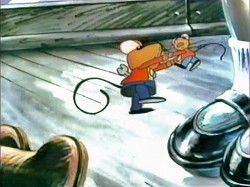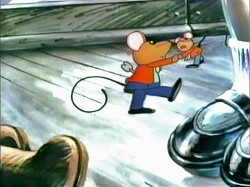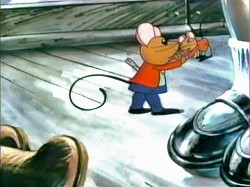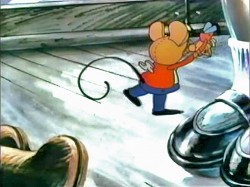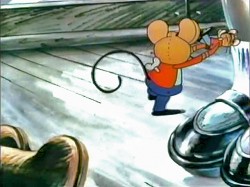Category ArchiveAnimation
Animation &Disney &Frame Grabs 11 Feb 2008 09:08 am
Whoopee!
- WHoopee! Congratulations to the BAFTA Awardwinners, Ratatouille and director Brad Bird for Best Animated Feature. Congratulations also to Jo Allen & Luis Cook and Aardman for The Pearce Sisters. Both are well deserving winners. Unfortunately BBC America opted to cut out their awards from the program. We didn’t get to hear the speeches.
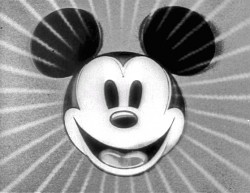 - Before there was video tape (which means before there were dvds), there was only 16mm film that you could project in your own home. I had (and still have) a nice collection of decaying movies and used to show these often. One of the regulars to show and watch and laugh at was the great Mickey short, The Whoopee Party. Everyone loved this short, no matter how many times we watched it. It’s a great film!
- Before there was video tape (which means before there were dvds), there was only 16mm film that you could project in your own home. I had (and still have) a nice collection of decaying movies and used to show these often. One of the regulars to show and watch and laugh at was the great Mickey short, The Whoopee Party. Everyone loved this short, no matter how many times we watched it. It’s a great film!
This encouraged me to watch it again on the B&W Mickey dvd I have. So I couldn’t help but jump for joy over the story sketches they include in the extras. Why not post them? So here they are – sketches from the limited storyboard they produced. I’ve also interspersed frame grabs from the film so you can compare images.
I could only get through half the work today, so I’ll post the rest of the film art tomorrow.
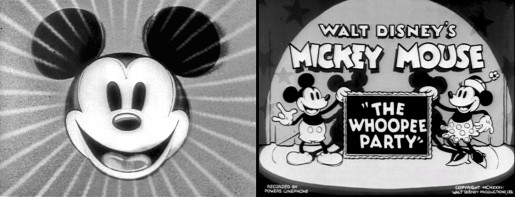
________________________(Click any image to enlarge.)
_______________________________The remainder of this post will finish up tomorrow.
Animation &Disney 09 Feb 2008 09:28 am
Lundy’s Grand Opera 2
- Continuing with yesterday’s posting of Donald drawings by Dick Lundy from Mickey’s Grand Opera, I have two more scenes to present. Actually, only the first comes from that film. It shows Donald pulling out his sword and belting out that first glorious operatic note.
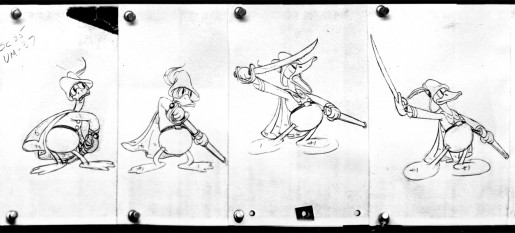 1
1
______(Click any image to enlarge.)
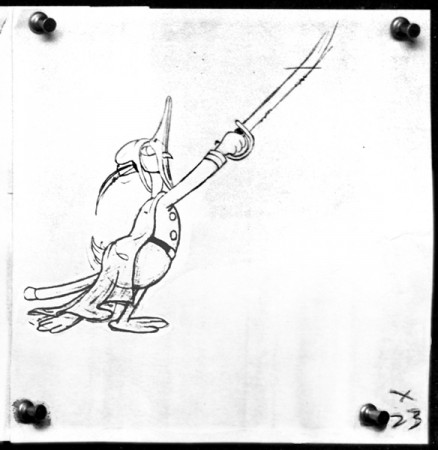 3
3This second scene comes from the original B&W Orphan’s Benefit (1934). Mickey walks Donald onto the stage, quiets the rambunctious orphans and Donald goes into this little dance just prior to his performance.
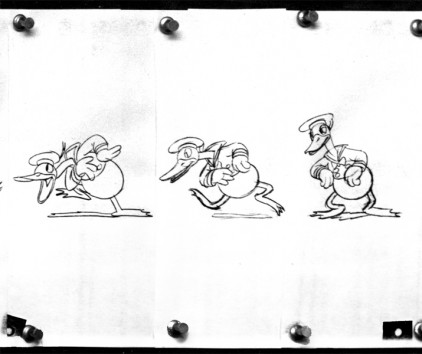 2
2
And here’s the frame grabs from the film which gives you the opportunity of comparing the inked cels from the pencil drawings. The inking hadn’t yet reached the same level of artistry, as you can see.
Animation &Animation Artifacts &Disney 08 Feb 2008 09:16 am
Lundy’s Grand Opera 1
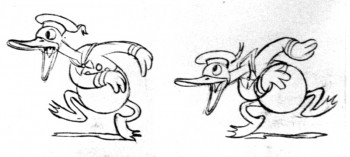 - Dick Lundy has always been an animator whose work I’ve enjoyed. I have some drawings that were prepared for publication (for some book or other) featuring my favorite Donald Duck.
- Dick Lundy has always been an animator whose work I’ve enjoyed. I have some drawings that were prepared for publication (for some book or other) featuring my favorite Donald Duck.
In this scene from Mickey’s Grand Opera (1936), Donald has just swallowed a frog which is bounding up and down and taking Donald with him. On a separate level, Pluto, who has been chasing the frog, barks.
I’ll soon post some more from this film with Donald preparing to perform.
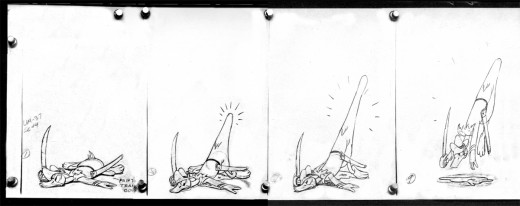 1
1
______(Click any image to enlarge.)
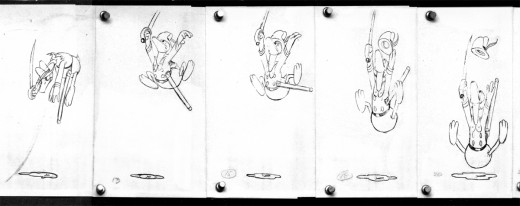 2
2
______
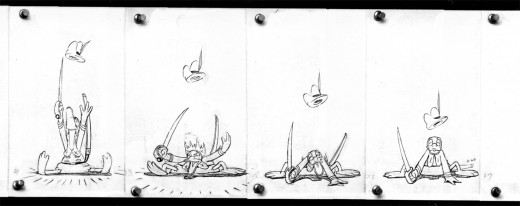 3
3
______
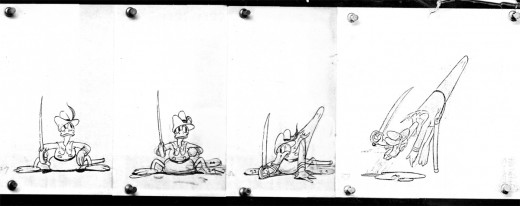 4
4
______
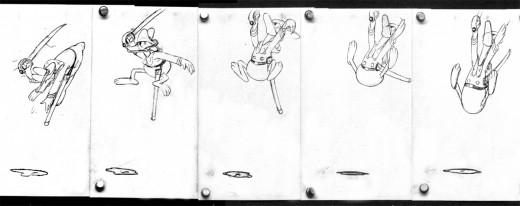 5
5
______
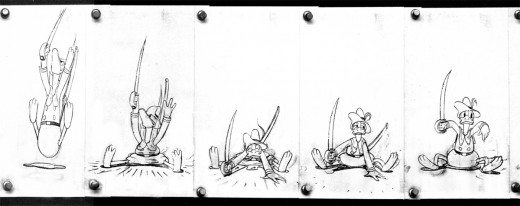 6
6
______
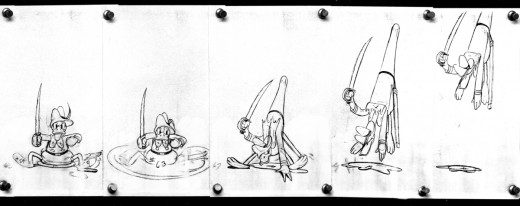 7
7
______
Animation &Daily post 07 Feb 2008 09:34 am
Award Beat
_
- There’s a comic book interview with Marjane Satrapi at Stripped Books. She shows herself to be a bright and articulate woman, even in English. No surprise in that.
_
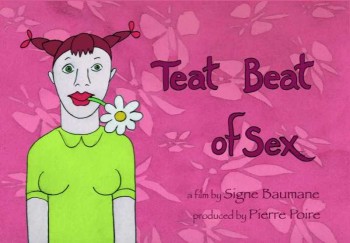 - Karl Cohen writes to inform me that two animated short films that were screened at Sundance and were invited to be part of the festival’s online shorts program, have been censored. As Nancy Denney-Phelps reports on her blog Sprockets, Signe Bauman‘s Teat Beat of Sex and Because Washington Is Hollywood for Ugly People, by Kenneth Ti and Kin Hung, were rejected by the online store for being, respectively, too sexually explicit and too political.
- Karl Cohen writes to inform me that two animated short films that were screened at Sundance and were invited to be part of the festival’s online shorts program, have been censored. As Nancy Denney-Phelps reports on her blog Sprockets, Signe Bauman‘s Teat Beat of Sex and Because Washington Is Hollywood for Ugly People, by Kenneth Ti and Kin Hung, were rejected by the online store for being, respectively, too sexually explicit and too political.
Director Baumane said about her film that it, “comes from corporations unwilling to take a risk. Corporations never push the envelope; it is individuals. It is remarkable that violence is OK, but not sex.”
Karl Cohen, president of ASIFA-SF, commented: “I see this as another stupid act of censorship that illustrates the dangers of having a few corporations in control of our media. TEAT BEAT OF SEX was commissioned for European television by a distributor and it is being shown there, but it’s considered too controversial to show on iTunes, Netflix, and Xbox. Isn’t something wrong with this picture?”
 - This Sunday, Feb. 10th, the BAFTA awards will be held. You can watch them on BBC in America at 8PM EST and repeated at 10PM.
- This Sunday, Feb. 10th, the BAFTA awards will be held. You can watch them on BBC in America at 8PM EST and repeated at 10PM.
The Animated Shorts nominated are:
- The PearceSisters – Jo Allen/Luis Cook
Head Over Heels – Osbert Parker/Fiona Pitkin/Ian Gouldstone
THE Crumblegiant – Pearse Moore/John McCloskey
I can’t help but note that The Pearce Sisters was nominated by BAFT for an award, this year, but it was skipped by the Oscars. Last year, the same was true of Dreams and Desires – Family Ties by Joanna Quinn. It’s a bit disturbing to me. Peter and the Wolf won the prize last year.
The nominations for the Best Animated Feature are:
Ratatouille – Brad Bird
Shrek The Third – Chris Miller
The Simpsons Movie – David Silverman
Not a good category. Ratatouille had best win.
By the way, in case you’re in London this Sunday and want to watch the red carpet in person check out this link for info.

- Mark Kausler has an excellent post giving us his thoughts on the Charles Schulz biography by David Michaelis. Mark includes a gem of a story about getting Schulz to sign a book. There’s something wonderful hearing about any small contact with greatness. See that autograph on his site.
_

- Finally, I have to again point you in the direction of Mark Mayerson‘s great blog. He’s posted another mosaic. This time he’s not picking apart a film, but a scene. It’s a Bob Wickersham scene from Thru The Mirror. He couldn’t have started with a better scene from a better film. Rod Scribner, check it out. I can’t wait for Mark’s written analysis.
Animation &Animation Artifacts &Disney 01 Feb 2008 09:11 am
Eating Cheese
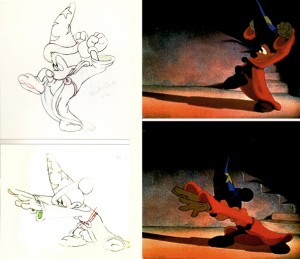 – The one of the “Nine Old Men” who generally seems to be left out of the starllight is Les Clark. At least, it seems that way to me.
– The one of the “Nine Old Men” who generally seems to be left out of the starllight is Les Clark. At least, it seems that way to me.
He started as an assistant to Ub Iwerks (inbetweening Steamboat Willie) ang did his first animation on The Skeleton Dance. (A skeleton plays the xylophone-like ribcage of another skeleton.) He brought the lessons he learned from Ub to the rest of his animation. He became the Mickey expert (animating the mouse in The Band Concert). He animated Snow White dancing with the dwarves, scenes of Pinocchio, himself, as well as the little train in the Baia sequence of The Three Caballeros.
John Canemaker has a nice chapter on him in his book, Nine Old Men & The Art of Animation. (I cribbed the image above from that book.)
Perhaps Didier Ghez will uncover some excellent interview for an upcoming edition of his fine series of books, Walt’s People.
Here’s a series of drawings from The Country Cousin where a mouse devours a piece of cheese.
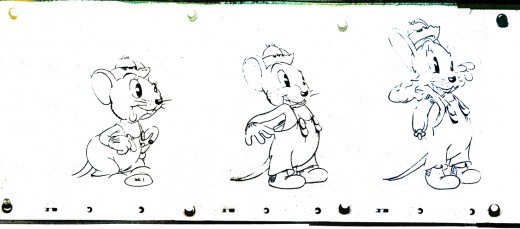
______(Click any image to enlarge.)
Animation &Commentary &T.Hachtman 11 Jan 2008 08:14 am
Notes:
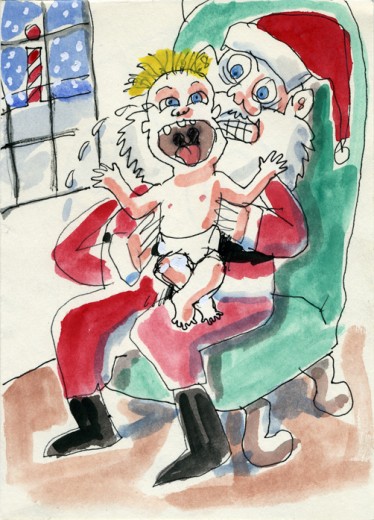
- Christmas is in the past, and the decorations are long gone.
Every year I save all the original cards and a couple of others I enjoy.
My favorite original card this year came from Tom Hachtman.
Tom wrote me about the development of this card:
– I sat down at the kitchen table to do cards with my niece April Centrone. She is a brilliant and somewhat demented artist. I gave her the Christ child from the creche and she began to draw – legs, body, hands and then, unhappy with the results, tossed it aside. I picked it up from there and put the baby in Santa’s lap.
The artwork was a collaboration. I wanted to clarify.
(Click any image to enlarge.)
____
- Marjane Satrapi received her best animated feature award this week from the NY Film
____Critics by saying, “In France, they always call the New York critics tough bastards. So
____thank you, my bastard friends.”
____It’d be nice to hear what she might say if she wins an Oscar. She’ll get my vote.
- The Pirate VeggieTale Movie got the reviews it deserved. The Village Voice’s Ed
____Gonzalez called it, “Humorless, incoherent, and ugly as sin…”
____I was going to attach an image from the film, but I couldn’t sink that low.
____However, I must say I prefer the Veggietales images to those from any of the Shreks.
- I love the gag cartoons that Stephen Worth has posted on the ASIFA Hollywood
____Animation Archive side. They’re from UPA New York, and they comment on
____Lu Guarnier’s having the only window in the studio. The studio was divided into stall-
____like cubicles. (At least, this is Tissa David’s description.)
____What fascinates me is that these cartoons were saved for the past fifty years! They’re
____absolutely worth it, but how much of the important art is gone, yet these inside-gags
____are still extant and in good shape.
____By the way, a comment from his niece Pat, reminded me that Lu had told me about
____his first name – that his father named him “Lucifer, the light bearer” because he would
____someday lead the world out of its darkness. He wasn’t named after Lucifer, the devil.
____This also had me wondering about the middle initial “B”. Lu wouldn’t tell me
____what it stood for and left me guessing whether it was for “Beelzebub.”
- Speaking of Stephen Worth, I’ve been entertained by the back and forth discussion
____between Michael Barrier and Stephen Worth regarding the history of story/script
____development at animation studios. Worth says that prior to 101 Dalmatians, all scripts
____for animation were done by storyboard artists. Mike Barrier (having viewed the
____evidence) states the obvious – scripts did exist as far back as the silent Disney days.
____I’ve seen enough of these scripts to know that Barrier is correct. The script for
____Brotherhood of Man was published in the 1945 Hollywood Quarterly, for pete’s
____sake. Hubley, Phil Eastman and Ring Lardner did this script in advance of
____any storyboard work, which Hubley, ultimately, did. I saw parts of that storyboard as
____well. I believe it’s now in the MoMA archives.
____Scripts did exist. Just look in the Merritt and Kaufamn book, Walt In Wonderland.
____Pg 102 has a verbal scene-by-scene breakdown with a follow-up board for the Oswald
____cartoon, Africa Before Dark. That’s 1929.
____I think in this argument, Stephen Worth is just fighting the hard fight to protect the
____claims of John Krisfalusi that only storyboarded scripts are good for animated films.
____The argument is not worth much more of a comment. The comments on Cartoon
____Brew have gotten beside the point.
____Barrier offers us a page of a Cinderella treatment & a Fleischer Koko silent film.
____There’s also another page of a Superman script on Thad Komorowski ‘s site
____contibuted by Bob Jaques.
____Need anyone offer more?
- Speaking of Mike Barrier, his comments about Hanna/Barbera, their shorts and Jerry
____Beck’s recent book, The Hanna-Barbera Treasury, are quite astute.
____His commments have also provoked some serious thoughts from Mark Mayerson
____about the subject. Mark comments, “There is no question that the animation industry
____suffered a major blow with the death of theatrical shorts and the rise of television. It
____took the industry more than 25 years to recover from that blow. Hanna and Barbera
____had no part in that recovery and if anything, they probably delayed it.”
____I certainly agree, but I’m more bitter. I don’t think there was ever a recovery from
____H&B’s handiwork. They put the animation industry in the gutter, and it hasn’t
____stepped out except for a few individual steps by others. A film like Persepolis suffers
____from the residue of Hanna Barbera’s flattening of animation. UPA introduced limited
____animation; H&B flattened it out.
_
_
_
_
- There’s another great Tom Hachtman image on the Kaliyuga Theater site for Al Carmines‘s play, In Circles about Getrude Stein. Tom, of course, draws the Gertrude’s Follies comic strip. This watercolor was done for Carmines. Tom sent it to me, and how could I pass up posting it?
I’m almost tempted to buy a ticket to the show.
_
-
_
Animation &Commentary &SpornFilms 10 Jan 2008 09:45 am
Tyer Breaking Joints
- Let’s talk about the breaking of joints. No, I haven’t entered Tony Sopranoland. This is an animation blog, so I’m obviously talking about the animation principle that deals with the “breaking of joints” to create any arcs or curves in animation. All human action is controlled by this method of movement. A body can only bend at joints – knees, wrists, elbows etc. Any other break is artificial and verboten in trying to make your character seem real. Any animator of the human form would swear by it.
Here’re four pages from Dick Williams’ book which illustrate the principle. Though if you look at his book – all those walks, all those bent wrists – this is one of the backbones of Dick’s training/education.
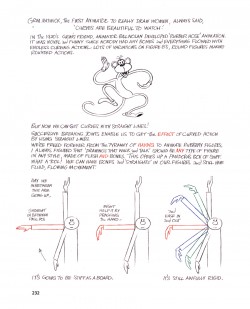 1
1 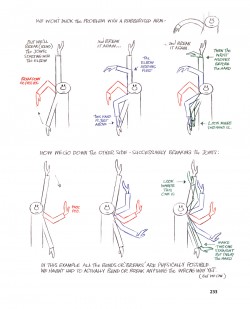 2
2
___(Click any image to enlarge.)
_
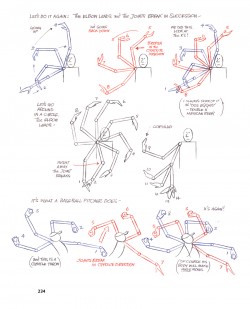 3
3 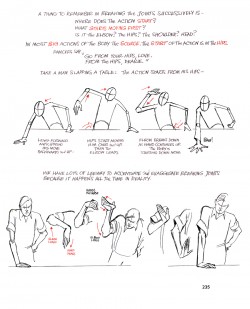 4
4
This is something I learned early on – long before I entered the business professionally.
I wasn’t sure it was spelled out in the Preston Blair book and went back to see, but it wasn’t. I don’t know where I originally read about it, but I must have somewhere – probably one of those old animation books I’d borrow from the library.
I’m sure they created it when animators at Disney in the early 30′s decided to get rid of the rubber-hose animation they’d been doing. It was a bit of rebellion. They followed the natural rules of physics. Today anything other than this would be the rebellion.
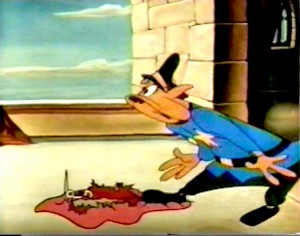 The one guy who broke this rule, and is just about idolized for it today, is Jim Tyer. His many distortions and odd working of his characters was an end in itself. This is probably what I liked about him.
The one guy who broke this rule, and is just about idolized for it today, is Jim Tyer. His many distortions and odd working of his characters was an end in itself. This is probably what I liked about him.
I’ve always seen animation as a way to caricature life not to recreate it.
Sidenote: This is why I don’t like most cgi films. They’re just trying to reproduce their form of life. Sure, Surf’s Up got those waves down pat; it’s almost perfect. Unless, of course, you’re looking for them to say something about waves rather than realistically rendering them and their movement.
Sorry, I respect it, but it’s like super-realistic painting done today; I have difficulty getting into it.
Animation is drawn. Drawing invites nonsense – even in the most serious of situations.
Tyer uses his graphic distortions to make scenes funny. In Fritz the Cat he handled some serious scenes with a quieter distortion, though it’s there just the same. It’s the acknowledgement that we’re watching an animated film that gets me charged. I like being in the moment and outside of it all at the same time.
Does that make sense?
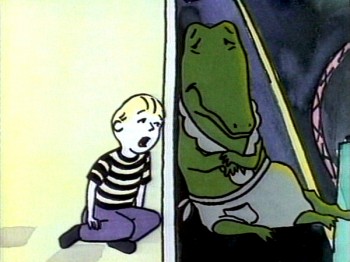 Lyle Lyle Crocodile was about a housekeeping, dancing crocodile that shares his house with a child. When his original owner comes to take Lyle away, the child gets upset, sings a song of remorse and cries. Lyle hides in a broom closet while the child sings from the other side of the door. I chose to view this as a cartoon. For god’s sake, it’s a cartoon crocodile that dances! For anyone who wants to see it, I’m mocking the situation. Visions of candy canes and ice cream cones dance around the croc’s head as he remembers the good days. I asked the composer to use a harmonica and a saxophone to pull the tears. Every time I see the scene I laugh hysterically. Most audiences don’t see this, and they weep for the boy and his pet.
Lyle Lyle Crocodile was about a housekeeping, dancing crocodile that shares his house with a child. When his original owner comes to take Lyle away, the child gets upset, sings a song of remorse and cries. Lyle hides in a broom closet while the child sings from the other side of the door. I chose to view this as a cartoon. For god’s sake, it’s a cartoon crocodile that dances! For anyone who wants to see it, I’m mocking the situation. Visions of candy canes and ice cream cones dance around the croc’s head as he remembers the good days. I asked the composer to use a harmonica and a saxophone to pull the tears. Every time I see the scene I laugh hysterically. Most audiences don’t see this, and they weep for the boy and his pet.
This is what I love. Something for me and something for people who don’t want that extra bit of separation. It’s actually a hard thing to pull off, but it’s great when you do.
The same bit is true about the breaking of joints. In every film, I go out of my way to break that rule and see if it’s noticeable. I’m not even trying to be as blatant as Jim Tyer. To be honest, I don’t think it is noticeable, although I see it every time. Tissa David hates when I do such things, but I can’t help it. I love the graphic distortions animation encourages, but I also love the rules of behaviour that help me tell staid stories. Hey, it’s great being the boss of me.
Animation 09 Jan 2008 08:29 am
Mouse & His Child
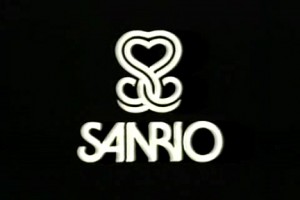 - Reviewing the career of Lu Guarnier, yesterday, I saw the title, The Mouse and His Child. This Russell Hoban book is an absoulte gem – a GREAT book. The film wasn’t quite its equal, but because the story is so brilliant, the film isn’t bad. Too bad they cut the last third of the book out of the film and ended the story early. Hoban told me that he hated what they did to his book, but I still like it.
- Reviewing the career of Lu Guarnier, yesterday, I saw the title, The Mouse and His Child. This Russell Hoban book is an absoulte gem – a GREAT book. The film wasn’t quite its equal, but because the story is so brilliant, the film isn’t bad. Too bad they cut the last third of the book out of the film and ended the story early. Hoban told me that he hated what they did to his book, but I still like it.
The film was done by Sanrio, a Japanese company that made all their money on Hello Kitty products. They produced two features in the US. Metamorphosis and The Mouse and His Child. Both films failed at the box office.
However, The Mouse and His Child, directed by Fred Wolf and Chuck Swenson, has some real charm. There are small glimmers of exciting animation throughout the film.
I don’t really know who did any of it. Corny Cole, obviously, did the big closing animated zoom of the film. I sought out the work of one animator I liked, and it turned out to be Vincent Davis. It was the first work I saw by him, and I’m still charmed by it.
Here’s a small walk at the beginning of the film. Lots of shape shifting in the assisting, but there’s something nice about it, too. I don’t know who animated it.
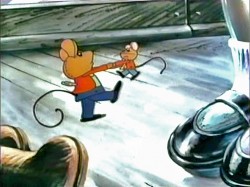 1
1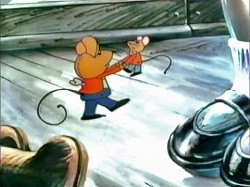 2
2
______(Click any image to enlarge.)
I like this film; I’ll probably have a bunch more to say about it eventually.
Animation &Commentary 08 Jan 2008 09:24 am
Lu Guarnier 1914-2007
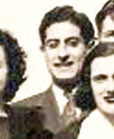 - I received word late yesterday that Lu Guarnier had died December 29th. He had been in poor health for some time, living at a nursing home in Marlborough, Mass. Lu was someone I considered a friend for years while I worked within the industry; we worked together for John Hubley, Phil Kimmelman and R.O. Blechman. He had a unique, rough, drawing style that was certainly a challenge for an assistant animator.
- I received word late yesterday that Lu Guarnier had died December 29th. He had been in poor health for some time, living at a nursing home in Marlborough, Mass. Lu was someone I considered a friend for years while I worked within the industry; we worked together for John Hubley, Phil Kimmelman and R.O. Blechman. He had a unique, rough, drawing style that was certainly a challenge for an assistant animator.
He once told me that his father took pleasure in naming him Lucifer B. Guarnier, and you can guess what the “B†stands for. He also enjoyed his annual trips back to LA where he still had a lot of friends._______Lu at WB.
Lu had started at Warner Bros. in the 30’s and told me many funny stories about working in Clampett’s unit. He started as inbetweener to Clampett and worked his way up to animator. $12 a week. He once told me of the “hurt†jokes that were enormously popular for a short period back in the day. How “hurt†was he?
Well, as an inbetweener, he was the last to receive some animation that Clampett had done in a particular Porky Pig cartoon. An axe was falling on Porky and at the very last moment, he was saved from the blade falling on him. Lu, for a joke – a “hurt†joke – decided to continue the animation with Porky being cut in two as an alternate ending that he sent to PT. After they watched the dailies, they could watch the alternate – the correct version. Well, it just so happened that that was the day Leon Schlesinger was making the rounds. The fresh dailies arrived and the assembled animation crew watched Porky cut in two. Leon turned to director, director to Clampett, Clampett to the lowly inbetweener who squirmed his way out of the room. Lu expected to be fired, but wasn’t; they all laughed after he’d left the room.
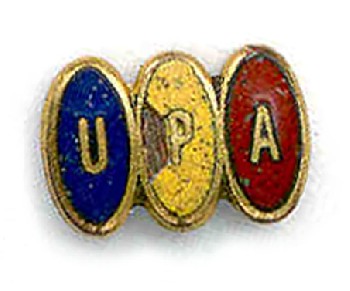
Tissa David told me that the UPA studio was one long space that was divided into cubicles. She called them “stalls†like horses would occupy at a racetrack. Grim Natwick, Tissa and Jack Schnerk shared the third cubicle. The only one who had a window was Lu Guarnier; he shared his space with Vince Cafarelli, his assistant.
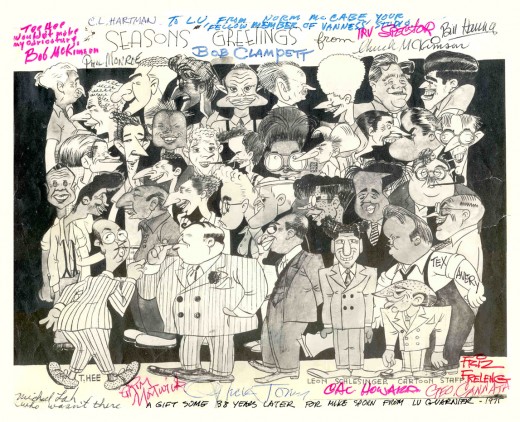 Lu was always a natty dresser, with a fine jacket, slacks and a bow tie. He gave me quite a few little gems that I’ve featured on this site. My favorite included the WB Christmas card filled with caricatures by Tee Hee. Lu, on one of his LA jaunts, had it signed by everyone he met. Tex Avery, Bob Clampett, Chuck Jones, Friz Freleng, both McKimsons. Even Hanna and Barbera. It’s a treasure, and I think Lu always regretted giving it to me. He often asked about it.
Lu was always a natty dresser, with a fine jacket, slacks and a bow tie. He gave me quite a few little gems that I’ve featured on this site. My favorite included the WB Christmas card filled with caricatures by Tee Hee. Lu, on one of his LA jaunts, had it signed by everyone he met. Tex Avery, Bob Clampett, Chuck Jones, Friz Freleng, both McKimsons. Even Hanna and Barbera. It’s a treasure, and I think Lu always regretted giving it to me. He often asked about it.
___________(Click image to enlarge.)
I’ve missed him since he went into the nursing home, after his wife died. Now, knowing he’s no longer there, I’ll miss him even more. He was a gem of a guy.
I have some drawings for a couple of scenes Lu animated. I’ll try to post one or two of them in the next week or so.
Animation &Books &Daily post 19 Dec 2007 09:35 am
Jack Zander and other thoughts
- Because I was never very involved in the commercial (meaning ads) end of the New York animation world, I didn’t have much contact with Jack Zander. Yet, I do know that he was a significant part of that end of the business in this city. Once you got past the names of Paramount and Terrytoons, Zander’s Animation Parlour was the big studio of my earliest days.
In fact, I probably had more contact with Jack’s son, Mark, over the years. The one interview I had at Zander’s was with Mark. It was one of those interviews where something in the air tells you that you’re never going to work at this place, so why try again. It was nothing Mark did; nothing I did. It just didn’t feel like I was a good fit. I didn’t try again and didn’t have much contact with Jack in the future.
Mark Mayerson let me know, last night, that Jack had passed away Monday at the age of 99. Mark also has one of the best, most succinct bios I’ve seen of Jack’s life on his site this morning. I urge you to check it out.
Tom Sito also has a nice post about Jack on his site today.
AWN has an interview with Jack Zander by Joe Strike.
Jack Zander was a significant figure in New York’s commercial history. He deserves some attention.
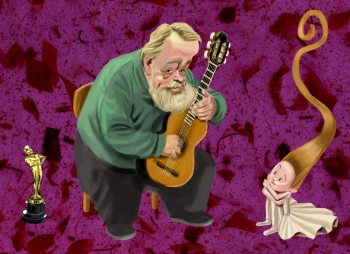 - Michael Barrier had a wonderful post at his website, Dec. 17th; it was on Borge Ring, and excuse to print his letter to Mike. I was a pleasantly surprised to see myself mentioned in the piece. Many people have said nice things about me, but this is the first truly poetic quote I’ve read. Borge is a poet of an animator.
- Michael Barrier had a wonderful post at his website, Dec. 17th; it was on Borge Ring, and excuse to print his letter to Mike. I was a pleasantly surprised to see myself mentioned in the piece. Many people have said nice things about me, but this is the first truly poetic quote I’ve read. Borge is a poet of an animator.
He made a small error though in commenting on my film, Dr. DeSoto. Borge said I made the film for $4000. In fact, it was $3500 per minute. I don’t think I could have gotten it photographed for $4000. I’m sure I miscommunicated, as usual, way back in 1984 when we spoke of that film. I hope he doesn’t like the film less.
If you’d like to see some of Borge’s work, Mark Mayerson wrote about him and led us to several films in 2006.
The illustration, above, is by Patrick Mate. I couldn’t resist swiping it for this post; it’s such a great picture and really captures Borge – in my mind, anyway. Patrick’s blog is worth checking into if you don’t know it.
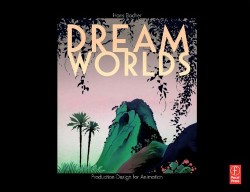 - I just received my issue of Hans Bacher‘s book Dream Worlds. It took a while for Amazon to get it out.
- I just received my issue of Hans Bacher‘s book Dream Worlds. It took a while for Amazon to get it out.
I haven’t read it as yet, but was astonished in carefully thumbing through it. With the same ardent enthusiasm I had for Amid Amidi’s Cartoon Modern and Mike Barrier’s The Animated Man, I encourage you to buy a copy of this book if you’re serious about animation.
It’s stunningly beautiful, filled with excellent art, attractively designed and it looks to be enormously informative. The book shows you what a production designer does in an animated film. I’ve seen no other book like it.
I will have much more to say about this book as I read it.
 1
1

 2
2
 3
3
 4
4
 5
5

 6
6
 7
7

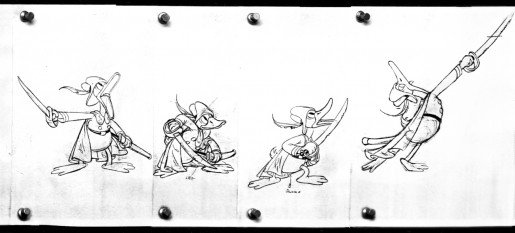 2
2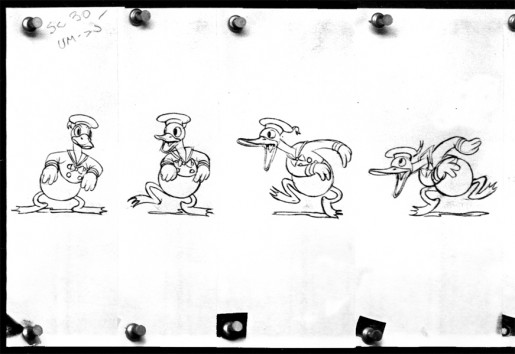 1
1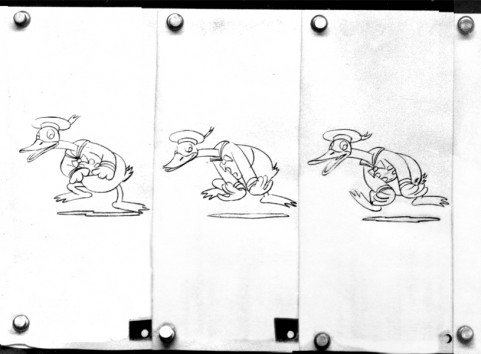 3
3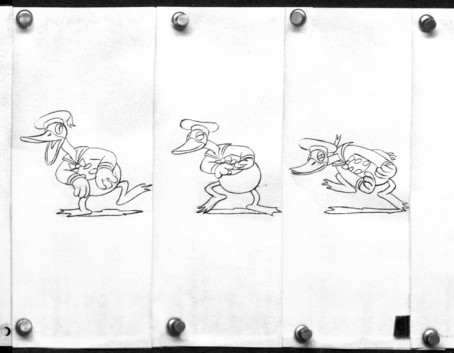 4
4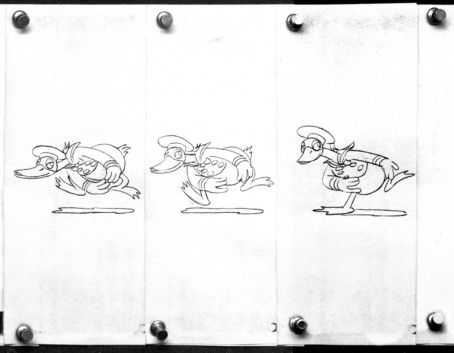 5
5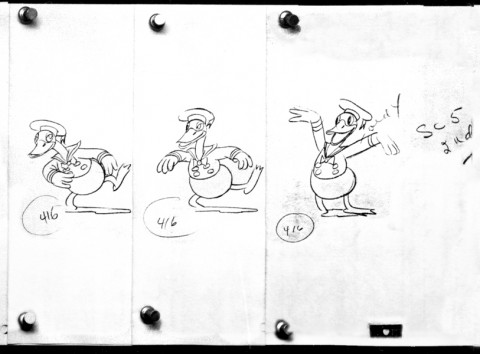 6
6 1
1 2
2 3
3 4
4 5
5 6
6